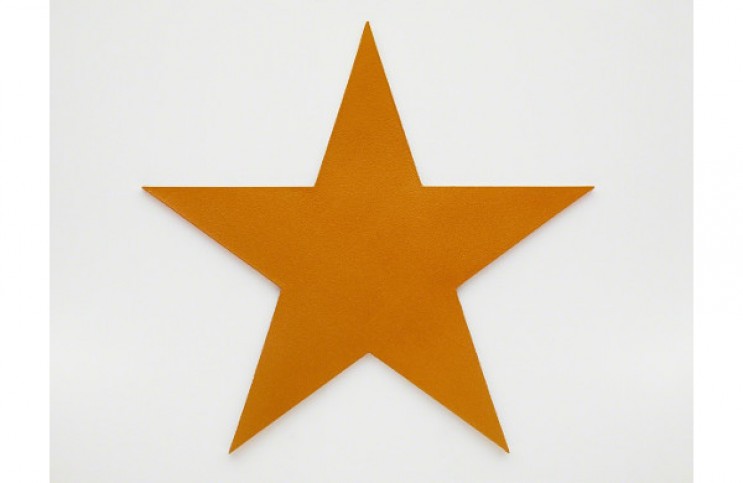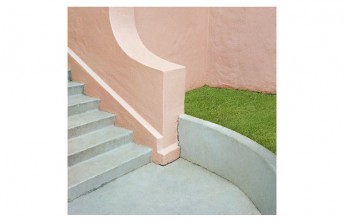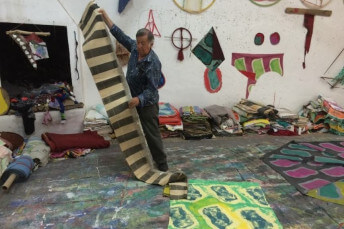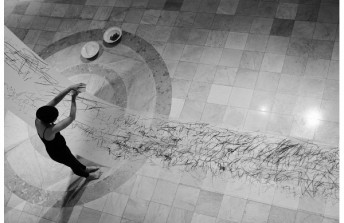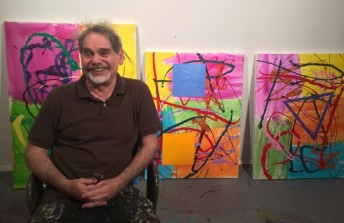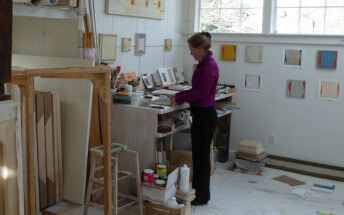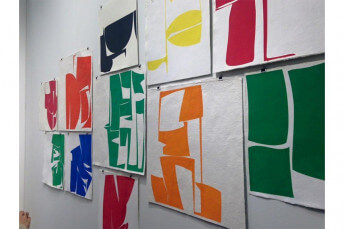A Revolutionary Painter – Our Interview with Olivier Mosset
Nov 2, 2018
Swiss-born abstract artist Olivier Mosset has been making revolutionary aesthetic statements for more than 50 years. His work is visually intense and minimal, based on a geometric, monochromatic language of forms. One reason I consider him a revolutionary is that he frequently exhibits motorcycles alongside his art. The paintings elevate the status of the bikes. The bikes make the paintings more democratic. He began this habit in the 1960s in Paris, while part of the minimalist art collective BMPT, which also included Daniel Buren, Niele Toroni, and Michel Parmentier. Most recently, he exhibited a 1957 Harley Davidson 74 Panhead along with two glittering large-scale paintings at MAMO, the breathtaking roof-top gallery of The Radiant City, an apartment building in Marseille designed by Le Corbusier. Both artworks and motorcycle conspired to transform the space into a shrine for the appreciation of beautiful, sensual, meaningful, inspiring objects. Mosset recently spoke with me from his home in Tucson, Arizona, where he has lived and worked since 1977. In our conversation, printed below, he generously shared his thoughts about many topics, including method, intention, and how art fits in with time.
Phillip Barcio for IdeelArt: What is the role of meaningful coincidence in your work? I mean, do you actively seek to construct compositions you believe will spark synchronicity in viewers?
Olivier Mosset: I don’t really know what people see and frankly I don’t care that much. Things don’t fall from the sky though. There is certainly something here that relates to other things and also to the conditions that allowed them.
IA: For me, your motorcycles have something to do with this idea. Even people with no art background instinctively respect them as objects for visceral reasons.
OM: I noticed that when you park a certain type of motorcycle on the street, people look at it.
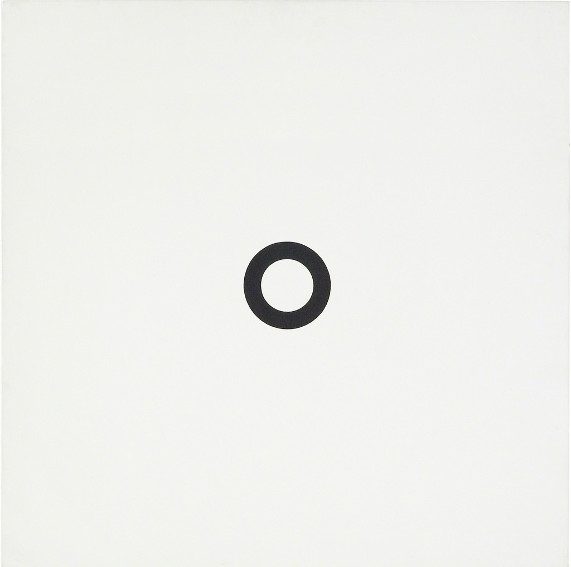
Olivier Mosset - Untitled, 1970. Acrylic on canvas. 39 2/5 × 39 2/5 in; 100 × 100 cm. Galerie Andrea Caratsch, St. Moritz
IA: Can you recall a time when a viewer who was otherwise ignorant about art felt welcomed into an exhibition by seeing your motorcycles in the space?
OM: The situation you are talking about may have happened at Hunter College: the gallery had a window on the street.
IA: My wife says your monochromes give a viewer a place to land on. Like, rather than offering a focal point, they offer a vantage point. Do you also understand your monochromes this way?
OM: I try to understand what I am doing by doing it.
IA: You once exhibited two works together—a black floor sculpture in the form of three conjoined pyramids and a pink painting with an orange line echoing the pyramid form. It solved a visual problem for me that is hard to put into words.
OM: Yes, at Campoli-Presti. You said that the visual situation was hard to be put “into words.” That's exactly the effect these works had on me.
IA: That installation seemed to transcend something you once said, that “painting is basically an institutional critique.” Do you think that is all painting can be?
OM: We are not going to define painting here. But for me a painting might question what it is, what other paintings are, and ultimately a system.
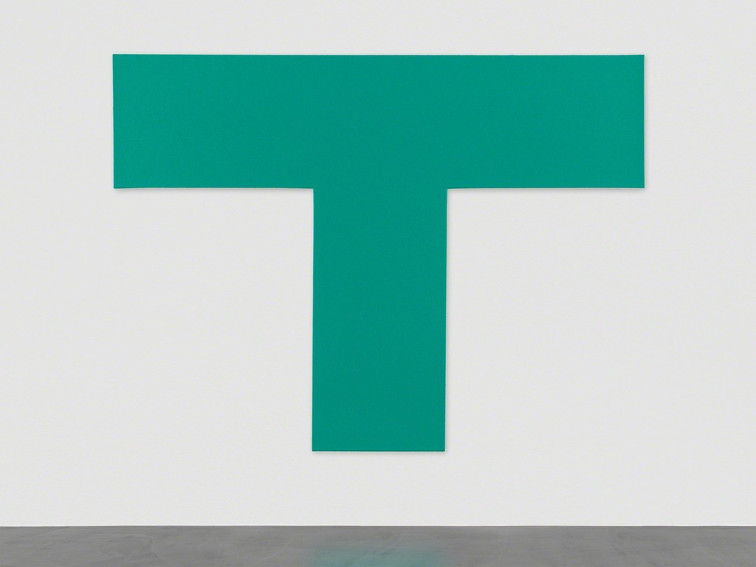
Olivier Mosset - Untitled (T), 2013. Polyurethane on canvas. 71 3/10 × 95 1/2 in; 181 × 242.5 cm. Galerie Andrea Caratsch, St. Moritz
IA: In as far as it relates to the objects you make, how does the natural landscape of your current home in Tucson differ from that of New York, Paris, and Bern?
OM: Here, we got cactus. But the paintings have their own logic.
IA: You once responded to a question about the origin of your work with the line, “Yes, things come from somewhere.” This seemed funny to me. Is the origin of art important compared to our reactions to it?
OM: There is a history you can't ignore, and of course an actual situation. I try not to explain things too much. Of course anybody can ask a question. They may not get an answer though.
IA: Does your art exist outside of time?
OM: I don't think you can escape time.
IA: I mean how does your work relate to so-called linear art history.
OM: “Wir sind einmal darin,” as the poet quoted by Freud said. [In Civilization and Its Discontents, Freud quoted Christian Dietrich Grabbe: “Ja, aus der Welt werden wir nicht fallen. Wir sind einmal darin.” (“Yes, we will not fall out of the world. Once we are in it.”)] We also have a history and an art history. The Greenbergian view of that history was interesting and somehow made sense in the 20th century. As far as I was concerned, I looked at the Renaissance, the Baroque, the XIX century, and the beginning of the 20th. I also saw what some other artists were doing at the time I was working. At the end of that century though, the situation seemed to have changed. Even neo-expressionism or neo-geo were still part of a dialectic, but after that, everything exploded. Anything was possible (which might not be bad), but to be honest, now, I am a little lost. In the end my practice is pretty selfish. That is why I don't like to talk too much about it. You might have to deal with what it is when you see it. It is all there. Done in a particular time and maybe not particularly relevant to that time.
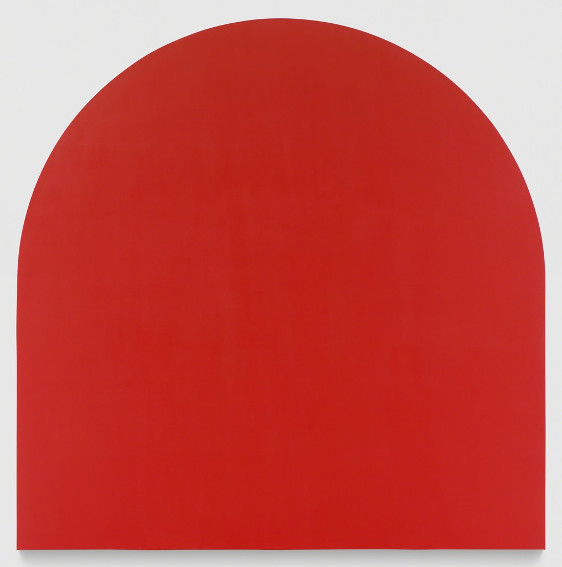
Olivier Mosset - Untitled, 2015. Acrylic on canvas. 116 1/2 × 116 3/10 in; 296 × 295.5 cm. Galerie Andrea Caratsch, St. Moritz
IA: An associate of yours from the Radical Painting Group once said, “I have needed to know that the making of a painting is the sole importance of painting.” This idea contradicts Agnes Martin, who said, “The response to art is the real art field.”
OM: Fred Thursz said that. [Robert] Ryman that it is not what you do that counts, it is how you do it. And as Agnes Martin might have said, ultimately it is what you see.
IA: What do you think is the difference between making art and responding to art?
OM: I have the feeling that I have to do these paintings in order to see them. And I am lucky enough to be able to show them, which helps to see what they are about.
IA: Do you consider your paintings to be signs? Or do you see them more as destinations?
OM: I don't really understand what you mean by destination and/or signs. It has been said that my paintings “direct towards something outside of themselves.” I would agree with that. Anyway, here too, it is the others who decide.
Through 17 November 2018, graphic works by Mosset are on view at Laure Genillard Gallery in London.
Featured image: Olivier Mosset - Gold Star, 2008. Polyurethane sprayed on canvas. 69 7/10 × 73 1/5 in; 177 × 186 cm. Galerie Andrea Caratsch, St. Moritz
